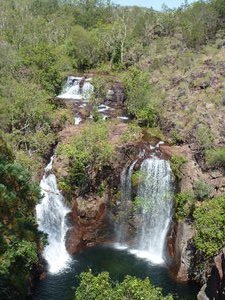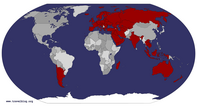Advertisement

 Florence falls in Litchfield National Park
Florence falls in Litchfield National Park
We swam under the falls and others jumped from the rocks at the side. In the wet season there is a lot more water.The Northern Territory is really one big open space. If it was a country it would rank 20th in the world and could hold 6 UK's. That is a lot of space for 250,000 people with the majority in the Darwin area. Unique in Australia 30% of the population is indigenous. (Sydney was such a dramatic contrast: in four days we only saw one small group of indigenous people the whole time.) Hence if you have access to a car Darwin makes a great place to find out more about the 20,000 year old Aboriginal culture especially in the 'Top End', the so called Northern part of NT.
There are several National Parks around Darwin many on indigenous land that they have leased back to the authorities. The first one we visited was Litchfield NP ninety minutes South of Darwin (named after the first European to see it). Rian was kind enough to drive us down for the day. There are magnificent waterfalls which are popular bathing spots we could indulge. Most fascinating were the termite mounds. There are 350 species of termites in Australia and only a few make spectacular mounds. The magnetic termites manage to build

 A magnetic termite mound in Litchfield NP
A magnetic termite mound in Litchfield NP
North is to the right. There is a cathedral termite mound in the background.their mounds only on a North South axis to help with temperature management. The cathedral termites are the height champions with mounds exceeding 5 metres after fifty years of building.
80km North of Darwin are the Tiwi islands. The Tiwis are a switched-on Aboriginal group who knew of no other humans until the odd Indonesian sea cucumber hunter and European explorers started appearing two hundred or so years ago. The islands are the second largest in Australia after Tasmania. It was a simple and interesting tour. We took a two and half hour boat trip to the islands from downtown Darwin. Dolphins escorted us in. At the main settlement, Wurrumiyanga, the high speed cat nosed on to the beach as there was no dock.
On the boat were two separate tour groups. Ours must have been the cheapest (still 250A$ per person) because we did not get lunch included like the others. The tour consisted of going around the main settlement to the main workshops, the sacred grave yard, the small museum and the mission church. After a while our ears attuned to the Tiwi guide's accent. Amongst the indigenous locals there are about

 This Cathedral termite mound is over 5 metres high
This Cathedral termite mound is over 5 metres high
The mound is active because you could see patches where the termites had repaired the mound recently40 Australians of European decent most working in education or development related jobs. The most famous is a nun, who is now 84 and who has lived there for 62 years. She even has a building in Rome named after her for her dedication to educating the children.
They took us to a small group of locals for morning tea cooked on an open fire with 'damper' scones. Here we started to learn about some the local rules: there are four skin groups on the island which is your inheritance through your mother. Your 'dance' group comes from your father. These determine how you paint your face at ceremonies.
Most importantly your skin group determines who you can marry. You can marry people from two of the three other skin groups only so preventing inter-marriage. In fact brother and sisters are not allowed in the same room or even to look at each other post puberty. (One chap solved the problem by marrying a lady of Greek ancestry from Darwin.)
They demonstrated the way they painted shells and wood and their faces. The pigments are all iron oxides (although the black
these days is commercial) with the yellow, orange and white being collected for a beach 70 km away on the North coast. They learn to paint their faces as soon as they can hold a paint brush and make it look so easy.
They performed various dances which described animals each of which is associated with a particular dance group and may be the appropriate one to perform at any given life ceremony depending of the ancestry of the people concerned. They also showed us the smoke dance a traditional greeting where they wash smoke over each guest.
We went from workshop to workshop meeting the locals making batik clothes, carving and paintings all in the style unique to the Tiwi clan. We talked to a guy carving a totem. He and his wife showed us his pieces in the nearby gallery. The totem was made of what they called 'iron wood' and was as hard as nails. Apparently it is one of the many varieties of eucalyptus.
The little museum and mission church were well presented. The latter had bullet holes from being strafed by a Japanese Zero in 1942.
The settlement had pre-warned Darwin by a few minutes of the impending attack and had the propeller of one Japanese aircraft downed nearby.
The Tiwis have their own language which is quite different from those of their neighbour Aboriginal tribes on the mainland. When the settlers came to Australia there were two hundred different languages spoken which has now shrunk to fifty. Interestingly the Tiwi language has now become the prominent indigenous language in Darwin because the language of the Larrakia locals originally in the area of the city has effectively died out.
The following week Anne had planned for us a three day visit to Kakadu National Park three hours West of Darwin. It is the largest terrestrial National Park in Australia. Most is wilderness. A rock escarpment runs through it which produces fantastic views especially in the glow of a falling sun. The highlights in the park are the aboriginal rock paintings and the wildlife around the wetlands. We were visiting at the very beginning of the season. There were a few other tourists and not many of the so called 'Grey Nomads' who tour Australia in their camper vans. Kakadu must

 Carving a totem from ironwood
Carving a totem from ironwood
Not the key tools are a chainsaw and axe.be fantastic in the wet season and is effectively inaccessible with the roads to the only town of Jabiru flooded from November to March. Much of the flat river valley become a large expanse of water covered by thunderstorm run off from the Arnhem Land escarpment.
It is estimated that around 2000 Aboriginals with five different language groups lived in the Park at the time the settlers arrived. Their numbers quickly dropped mainly due to the new diseases the Europeans brought, for which they had no resistance. Prior to the Europeans the Aboriginals were nomadic. They sheltered and painted on rock outcrops by the escarpment. There are 5000 known painting sites in the park and there may be as many as 10000. All are sacred and most are not accessible or open to the public. Those that are show the variety of designs and the development of the art which uniquely has evolved over 20,000 years.
Apparently the act of painting was more important to the painter than the finished article. The over painted layers are clearly visible in places. The most famous paintings are the so called X-ray style which show backbones etc
as well as the external shape of animals and humans. Most paintings relate to stories from the 'Dreaming' the mythical period so many Aboriginal ancestral stories come from. They have been dated using many methods. For example, there are some of animals (Tasmanian tigers) that were known to have gone extinct in the area by a certain period many thousands of years ago. More modern ones may have pictures of guns. Some of the most picturesque are probably the fish and the experts have been able to identify many different species.
We went to the two main sites at Ubirr and Burrungay to see the paintings. There are guided trails to help you interpret the pictures. The painting are also in areas where the nomadic Aboriginals had shelters. Their floor levels have been excavated to show occupation over more than 20,000 and possibly as far as 50,000 years ago.
There are many wetland cruises on offer. We avoided the ones where they entice crocodiles to jump from the water with meat. Anne sensibly directed us to book the Yellow Water evening cruise to catch the sunset and more wildlife. It reminded me of the
trips I would make with my family years ago to the Everglades in South Florida. A lot of the wild life was surprisingly similar. OK they were crocodiles not alligators. There were many Darters/Anhingers drying their wings by the side of the waterway. The most majestic bird was the Jabaru/Black necked Stork. Kingfishers were common and less shy then their European cousins. Ducks don't quack in the Kakadu, they whistle. A sea eagle floated overhead looking for pray. The sunset brought a spectacular end to the day (see panorama).
We stayed overnight in a 'bush cabin' In Jabiru. This was a basic tent shape room with a bunk, double bed and sink. There was a BBQ area in front that we used as the kitchen and dining room. You got your own toilet and shower block. We had to share it one evening with a children's python. I used a pair of BBQ tongs to throw the snake into the long shrubbery surrounding the site.
On the trip home we stopped at Fogg Dam. This was built as part of a rice growing project from the 1950's which failed despite the NT being a

 The Tiwi skin groups which are passed down by the mother
The Tiwi skin groups which are passed down by the mother
A fish can marry a rock or sun and not a tree. A sun can marry a fish or tree and not a rock.......and so on.key resource for wild rice species. The dammed wetlands are now a magnet for birds and animals. It is apparently full of large pythons but you do not see them in the day time. We did see a large fresh water crocodile, spoonbills and, much to Jane's delight at last, a pack of Wallabies. Thanks, Anne for sorting that!
Fire is very much part of the Kakadu life cycle. The aboriginals knew how to use it to rejuvenated the bush. The current accepted wisdom is to burn off swathes of freshly dried out bush at this time of year before the grasses get too long and potential cause 'hot' fires later in the dry season. The burning attracts the kites and eagles because they know it will cause small animals to run from their cover. One fire burnt next to the road as we left (see panorama). It was plenty intimidating enough at this time of year.
It is a long days drive to Alice Springs and still further on to the NT border so you can how little of this vast area we have covered. Having said that we have had exposed to
the indigenous cultures in a way that just does not seem to exist in a city like Sydney and seen a unique part of the world. Thanks for being there Anne!
Advertisement
Tot: 0.313s; Tpl: 0.014s; cc: 20; qc: 51; dbt: 0.093s; 1; m:domysql w:travelblog (10.17.0.13); sld: 1;
; mem: 1.2mb





















RJT
Rachael
What a wonderful exploration of the "top end"! I have seen a little and absolutely loved it, but I think you have inspired me to see even more!